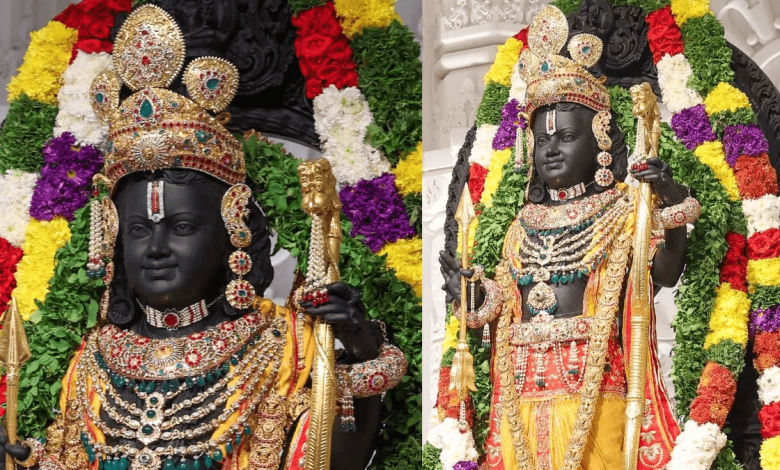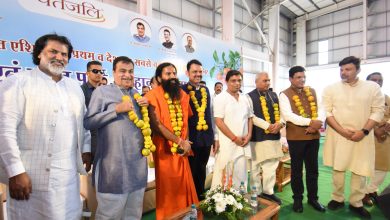Ayodhya: Ram Lalla to wear cotton clothes in the summer season; Mandir Trust shares a picture of the deity dressed in handloom cotton

summer season: In the heart of Ayodhya, amidst the ancient city’s rich tapestry of culture and spirituality, a significant change is underway. Ram Lalla, the revered deity, is set to embrace a more comfortable attire as the scorching summer (handloom cotton) heat envelops the region. This transition to cotton clothing reflects a thoughtful measure to ensure the deity’s comfort amid the relentless summer swells.
Considering the arrival of the summer season and the rising temperatures, starting today, Bhagwan Shri Ramlala will be wearing cotton vastra.
— Shri Ram Janmbhoomi Teerth Kshetra (@ShriRamTeerth) March 30, 2024
The vastra that Prabhu is wearing today, is made of handloom cotton malmal, dyed with natural indigo, and adorned with gotta flowers.… pic.twitter.com/BtDyzQXYgp
The Significance of Ayodhya
Ayodhya, often referred to as the birthplace of Lord Rama, holds profound significance in Hindu mythology and culture. It’s a place where spirituality intertwines with everyday life, drawing devotees and tourists alike to its sacred precincts.
Ram Lalla: Symbol of Devotion
an infant form of Lord Rama, holds a special place in the hearts of millions of devotees. The deity’s presence in Ayodhya’s revered temple complex is a focal point of devotion and pilgrimage, attracting devotees from far and wide.
Embracing Comfort in Tradition
In a thoughtful gesture, the custodians of the temple have decided to shift Ram Lalla’s attire to cotton garments as summer approaches (summer season). This decision stems from a deep-seated tradition of ensuring the utmost comfort for the deity, reflecting the reverence and care bestowed upon Ram Lalla by the devotees.
The Essence of Cotton Clothing
Cotton, with its lightweight and breathable properties, offers the ideal solution to combat the oppressive heat of the summer months. By adorning Ram Lalla in cotton attire, the custodians aim to ensure not only physical comfort but also spiritual tranquility, fostering a serene environment within the sacred precincts.
Preserving Tradition Amidst Modernity
In a rapidly evolving world, where traditions often intersect with modernity, the decision to dress Ram Lalla in cotton symbolizes a harmonious blend of age-old customs and contemporary sensibilities. It underscores the timeless relevance of tradition in fostering a sense of continuity and reverence in a changing landscape.
As Ayodhya prepares to welcome the sweltering summer (summer season) months, the transition of Ram Lalla to cotton clothing epitomizes a delicate balance between tradition and comfort. It signifies a profound gesture of devotion and care, ensuring that the revered deity remains enveloped in comfort amidst the scorching heat. In this timeless city where the past meets the present, the essence of tradition continues to thrive, resonating through the corridors of faith and devotion.
FAQs (Frequently Asked Questions)
1. Why is Ayodhya significant in Hindu mythology?
Ayodhya is revered as the birthplace of Lord Rama, making it a sacred pilgrimage site for Hindus worldwide.
2. What is the significance of dressing Ram Lalla in cotton clothing?
Dressing Ram Lalla in cotton ensures both physical and spiritual comfort amid the sweltering summer heat, reflecting the devotion and care of the custodians.
3. How does the transition to cotton attire preserve tradition?
The decision to dress Ram Lalla in cotton (handloom cotton) exemplifies a harmonious blend of tradition and modernity, showcasing the timeless relevance of age-old customs in contemporary times.
4. Is Ram Lalla worshipped by people of all ages?
Yes, devotees of all ages hold reverence for Ram Lalla, reflecting the deity’s universal appeal and significance in Hindu culture.
5. What does the transition to cotton clothing signify for devotees?
For devotees, the transition symbolizes a gesture of devotion and care towards the deity, fostering a deeper connection and sense of reverence.









